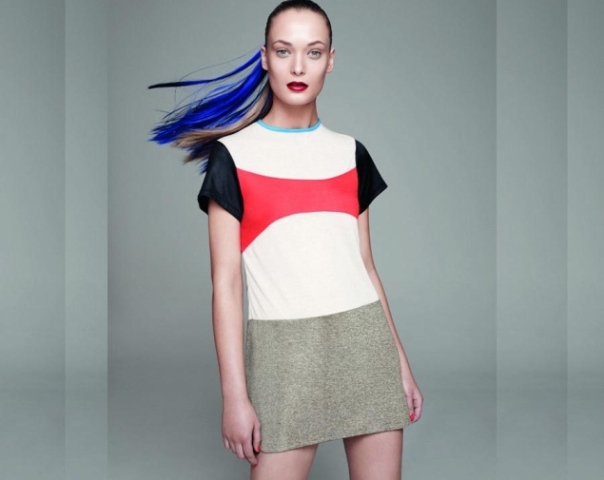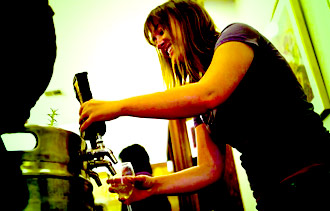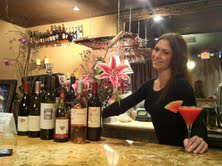Category Archives: Going Green
Topshop going green with eco capsule line; Aims to encourage sustainability within the fashion industry
Following hot on the heels of H&M’s sustainable Glamour Conscious Collection, high street retailer Topshop has teamed up with eco fashion brand Reclaim To Wear to create a debut upcycled capsule collection made entirely from discarded materials.
Materials including surplus stock and production off-cuts have gone into the line, which comprises on-trend pieces including ombre bleached denim shorts and color block panel mini and maxi dresses.
On sale from June 8 at the retailer’s London Oxford Circus store and online, the line aims to encourage sustainability within the fashion industry.
Aiming to solve the problem of textile waste, Reclaim To Wear was founded in 1997. The brand’s creative director Orsola de Castro and managing director Filippo Ricci shared their knowledge with Topshop when collaborating on the line.
“This is the first step towards the creation of zero waste design collections. I trust that the Topshop team’s commitment to new sustainable solutions will lead to the reconsidering of consumption versus disposal throughout the whole fashion industry supply chain,” said de Castro.
The new eco friendly Topshop line follows a general shift in the fashion industry towards upcycling and sustainable fashion. On the high street H&M launched its Glamour Conscious Collection back in March, comprising pieces made using sustainable materials including organic cotton, hemp and recycled polyester.
Big name designers have also been getting in on the act, with a host of labels including Valentino and Lanvin signing up to film producer Livia Firth’s Green Carpet Challenge initiative ahead of the awards ceremony season earlier this year.
Highlights on the Oscars red carpet included best actress winner Meryl Streep’s gold draped Lanvin dress made out of eco-certified sourced fabric and Firth’s red Valentino gown made of recycled polyester sourced from plastic bottles.
Article excerpted from www.nydailynews.com
Eco-city not green, but offers hope
New city will provide an opportunity to test new technologies that can be used elsewhere
The world’s largest eco-city is not a green, carbon-free paradise where cars are banned from the streets.
Instead, as its first residents moved in this month, they found it is remarkably like most other Chinese cities: shrouded in smog and depressingly grey. But then the Sino-Singapore Tianjin Eco-city, just over an hour from Beijing by train, is not supposed to be a whizzy vision of the future.
It is far more practical – a model for how Chinese cities could develop and solve some of the enormous problems facing them: permanent gridlock, a lack of water and ruinous electricity bills.
If a few of the changes adopted in Tianjin were rolled out nationally, the results could dramatically change China’s devastating impact on the environment.
“Our eco-city is an experiment, but it is also practical,” said Wang Meng, the deputy director of construction. “There are over 100 eco-cities in the world now, and they are all different. If you look at the one in Abu Dhabi, they spent a huge amount of money and bought a lot of technology. It is very grand, but is it useful?”
To date, almost all of the world’s eco-cities have been green follies, crippled by a central parado the more they enforce bothersome environ-mental rules, the less people want to live in them.
In Tianjin, the residents will not be expected to make any particular effort to be green.
“If they take the bus and sort their rubbish for recycling, they will be making their contribution,” said a spokesman for the city.
Their main contribution, in fact, is to be guinea pigs as planners experiment with the city around them. General Motors, for example, is using Tianjin to work out if electric driverless cars can function in a normal traffic system.
“Some eco-cities are too idealistic. In Tianjin they do not want to stop people from driving, but they do want to put into place policies that will help our vehicles to operate success-fully,” said Chris Borroni-Bird, the head of GM’s autonomous driving project in Detroit.
He said Tianjin would allow GM to road-test the next generation of vehicles: small urban cars that drove themselves but were safe in an environment full of unpredictable drivers and pedestrians.
Not only does China desperately need to solve its traffic problems, but it is one of the few countries that can throw significant resources at new ideas and build cities from scratch in order to experiment.
Other projects on trial include a low energy lighting system from Philips and garbage bins that empty themselves, sucking litter into an underground net-work, by a Swedish company called Envac. “We are not sure about that one,” said a spokes-man. “It requires people not to put the wrong sort of rubbish in the bins, or it could jam the system and prove expensive to maintain.”
By the time it is finished, in the next decade or so, 250 billion yuan ($40 billion) will have been spent by the Chinese and Singaporean governments, and a number of private companies, on transforming the site into a comfortable home for 350,000 people. Sixty families have already moved in.
Already, one new technology has been patented. “We had an industrial reservoir that was full of heavy metals,” said Wang. “It used to be so bad that people could not go near it because of the smell. Now we have cleaned it with a special process that we can send to other parts of the country.”
In a country where 70 per cent of the rivers are too polluted to provide drinking water, the technology is likely to be a money-spinner. Having ruined vast swaths of its countryside as it raced to wealth, China is now likely to spend billions on cleaning up the mess.
Elsewhere, government-owned buildings collect their own rain water for reuse, are powered by geothermal energy, have window shutters that move with the light, in order to keep buildings cool, and heating systems that use solar energy.
In a sign of how seriously the project is taken, eight out of the nine members of China’s politburo standing committee, which rules the country, have visited.
“The idea is to create something that can be adapted to other cities in China,” said Wang.
How to Recycle at the Workplace
According to the U.S. Environmental Protection Agency (EPA), as much as 90 percent of work-related waste is paper, making it recyclable. Starting a workplace recycling program takes initiative, organization and education. Preparing and launching a program take time, but after the program is in place, your workplace can significantly reduce its waste output, lower its carbon footprint and even generate a small amount of income for your company.
Items you will need:
- Recycle bins
- List of approved recyclables
Tips
- Encourage participation in your recycling program by letting employees know how much waste is being recycled monthly. People like to see the impact of their efforts.
- Redistribute the recycling guidelines quarterly to keep them fresh in everyone’s mind. Email the guidelines to reduce paper waste.
- Communicate clearly with your company’s janitorial staff about the recycling program’s efforts. This helps to ensure that items in recycling bins are not being collected with regular office trash as the janitorial staff cleans.
Article excerpted from http://greenliving.nationalgeographic.com/
Mitsubishi i-MiEV Eco Tourism Pilot Demo Program starts – EV is now available at Four Seasons Resort, Langkawi
Langkawi seduces, not for the first time. Peering out from MH1438′s window, the cluster of 99 islands in the blue sea that make up Langkawi immediately calms the mind, and brings a smile. And when the Four Seasons Resort is your home away from home, you’ll want to stay for awhile. But we got work to do, so time to get down and dirty.
Or not, because the car we’re here to drive is as clean as they come. Mitsubishi Motors Malaysia, which in October last year became the first to register a full electric vehicle in Malaysia, is launching its Eco-Tourism Pilot Demonstration Program, starring the i-MiEV.
If you don’t already know, the i-MiEV is based on MMC’s i minicar, but there’s no internal combustion engine and no need to refuel, because it’s 100% battery powered and rechargeable. Zero tailpipe emissions, too.
And it’s no fancy concept either – the i-MiEV is a production car already on sale elsewhere, and hopefully one day, Malaysia. It was first sold domestically in 2009, before European sales started in 2010. The little car was launched in North America late last year.
Here’s how the program works. MMM is loaning one unit of the i-MiEV to Four Seasons Langkawi, where guests of the five-star resort can use around the island, for free. No money required, just feedback.
This will go on for two months from 23 February. The stated mission is to gain better understanding of customer behaviour and expectations from an EV. There’s some prestige to be had for both parties too, in my opinion, since everyone is flashing their eco credentials these days.
“Fundamentally, eco tourism means making as little environmental impact as possible and encouraging the preservation of environment when visiting a place. 100% electric with zero emissions, yet offering surprising power and a smooth quiet ride, the i-MiEV is the greenest way to drive in Langkawi,” Tetsuya Oda, CEO of MMM proclaimed.
“This fits perfectly into our philosophy of engaging in sustainable practices that conserve natural resources and reduce environmental impact,” Philippe Larrieu, Four Seasons Langkawi Resort Manager chipped in.
We understand that after its stint at Four Seasons, WVY 159 will continue to serve Langkawi at another location. By the way, MMM, as pioneer, went through nearly one year of working with various authorities to help chart a new course in a system where tax is charged according to engine cubic capacity (the i-MiEV has none, remember), among other obstacles.
And of course, there’s the usual process of getting type approval etc. If you’re wondering, road tax for the i-MiEV is RM10 per year, after a 50% EV discount. Not sure how they arrived there, though. Notice the road tax sticker says “49000 W” in place of where the engine cubic capacity normally as – it reflects the i-MiEV’s 49kW motor power.
At the event, we also learnt something new from Takayuki Yatabe of MMC’s EV Business Promotion Department. In a “did you know” moment, the Tokyo based exec shared that the i-MiEV is great as an emergency power source, since its lithium ion battery pack stores the equivalent of one and a half days of the electricity used by a typical Japanese household.
He added that MMC is developing tech that will allow i-MiEVs to supply up to 1,500 watts of electricity to power electric jugs, rice cookers, hair dryers, and other small but vital appliances. Not so useful here perhaps, but Japan is frequently hit by earthquakes, which could knock out electricity supply. In fact, 60 units of the i-MiEV were used for relief purposes in the earthquake/tsunami disaster last year, when gasoline supply dried up.
After all that, I hopped into the car for a spin round the block. Having driven various EVs before, including a pre-production i-MiEV, the stint wasn’t as eye opening as it could be, but it’s still a stark contrast from regular motoring. For one, you twist the key (same design as other Mitsus) but there’s no resulting sound or vibration, only a signal from the instrument cluster that the i-MiEV is ready to roll. Step on it and it glides off with a synthesised whirr.
Yes, the sound on take off and low speeds is manufactured and comes out from a speaker. This is for safety purposes, in case pedestrians can’t hear an EV coming. Apparently, the sound has been agreed upon by all carmakers, sort of like an “official EV noise” if there’s such a thing. Sounds very natural, and I wouldn’t have noticed if they didn’t say, honestly.
Keep your foot on the gas and the ample torque (180 Nm from rest) gets you to highway speeds in a blink. It’s like a powerful regular car, just without the engine/exhaust note we’re accustomed to. The rate of acceleration tapers off once you’re cruising along, but one’s not meant to race around in this anyway. Instead, keeping an eye on the Charge/Eco/Power bar becomes second nature. Lower is better, battery lasts longer.
Everything else feels regular, except that tyre roar becomes so much more apparent when it’s the only noise you hear. The steering felt a little heavy for me, although there’s no big issue with the regenerative brakes (some early hybrids with these brakes had odd pedal feel).
The i-MiEV is a great runabout, and I can see myself driving it everyday without compromise. Measured by the New European Driving Cycle (NEDC) the car is capable of 150 km on a full charge. Even if we take 100 km as a realistic figure, many daily routines will be covered, and charging can be done overnight (eight hours at 230 volts). Can’t be that cumbersome, since some people charge their smartphones more often than that!
The only thing stopping MMM is cost. EVs and their batteries are currently expensive to make, and it will be uncompetitive without government incentives in the form of rebates and subsidies. If you’re wondering how long the batteries in the i-MiEV will last – Mitsubishi estimates about 70% capacity by the end of 10 years.
o give you an idea, the Japanese government gives a subsidy of 50% of the difference in price between EV and regular model. For instance, if a 660cc Mitsubishi i is RM100k and the i-MiEV’s natural price is RM200k, the subsidy will be worth RM50k. Currently, the G model i-MiEV is priced at JPY 3.8 million (RM145,017), but after subsidy, the price becomes JPY 2.84 million, or RM108,381. In the US, the i-MiEV is priced around $29k after rebate.
Norway is a great example of how popular an EV can be with support. Tax and VAT exempt, the i-MiEV also pays zero toll and can use bus lanes, making it the best selling A-segment vehicle in the country. Is the future electric? It’s all about the money, at the end of the day.
Article excerpted from www.paultan.org
Bieber goes green as he turns 18
JUSTIN Bieber has been given an eco-friendly runaround for his birthday.
The Baby singer, who turned 18 today, was presented with the luxury Fisker Karma vehicle with a solar-panelled roof by his manager Scooter on a US chat show.
And Scooter told the teen star he had broken his own rule to avoid anything ‘flashy’ and revealed the car — which cost between £64,000 and £72,000 — was from himself and Justin’s mentor, Usher.
He said: “You work really, really hard. I always yell at you don’t get anything flashy. You know, we’re not about that. Be humble, be humble and I kind of broke my own rule.
“So we wanted to make sure you were environmentally friendly and we wanted to make sure since you love cars that when you’re on the road you are always environmentally friendly and we decided to get you a car that would make you stand out.
“I think you know where I’m going and you’re kind of freaking out right now.”
And host Ellen DeGeneres presented the teen idol with her own birthday presents – a windscreen shield with her face and his in a heart, and an Ellen bobble-head for his dashboard.
The Canadian crooner, who is dating Selena Gomez, has been collecting luxury motors since he turned 16, the legal driving age in the US.
Last year, he treated himself to a £100,000 customised Range Rover, which had a sound system worth £50,000, leather interior, modified paintwork and a Cosworth engine.
He also owns a Batman-themed customised Cadillac and a Ferrari.
Justin received a birthday tweet from Cheryl Cole on his big day.
She wrote: “Happy Birthday @justinbieber ! I hope you have an Amazing 18th that you never forget.. *kisses*
But girlfriend Selena, who is away filming in Florida, has so far failed to mention his birthday.
Maybe she’s keeping her birthday messages strictly private.
Article excerpted from www.thesun.co.uk


























